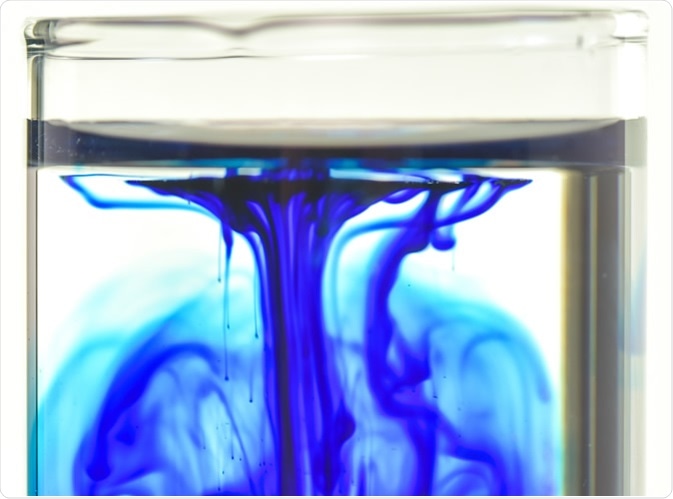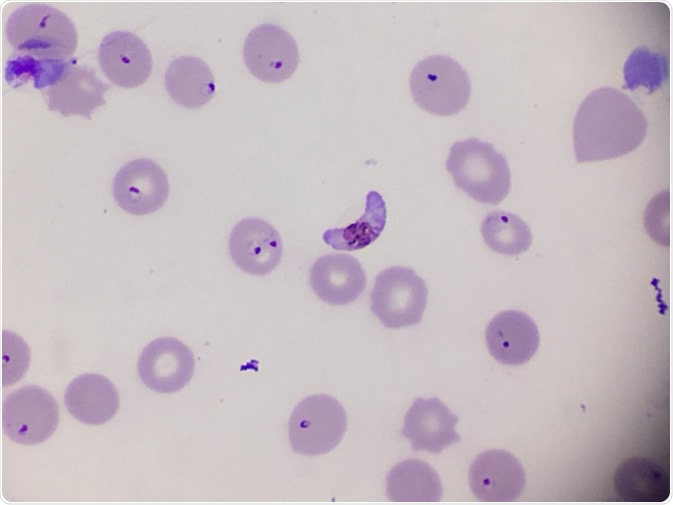What is methylene blue?
Originally synthesized in 1876, methylene blue is a diaminophenothiazine that has a low redox potential of 11 mV, thereby allowing this compound to readily cycle between its oxidized and reduced form1. Methylene blue, which has the chemical name of 3,7-bis(dimethylamino) phenothiazine chloride tetra methylthionine chloride, is highly soluble in both water and organic solvents, thereby allowing this chemical to freely enter cells and various organelles, including the mitochondria, lysosomes, and nucleus. Within the mitochondria, methylene blue facilitates the movement of electrons while reducing the production of superoxide molecules.
Methylene blue was the first fully synthetic drug to be used in medicine for the treatment of malaria parasites2. Historically, methylene blue was also incorporated into the medication of psychiatric patients so that clinicians could monitor their adherence due to blue urine among compliant patients.

Methylene blue fall in water in glass tube. Image Credit: FreeProd33 / Shutterstock
Industrial uses of methylene blue
Outside of medicine, methylene blue has primarily been used as a synthetic dye for paper, as well as wool, silk, and cotton textiles. When used to color textiles, methylene blue adheres to the interstitial spaces of cotton fibers to integrate into fabrics.
Methylene blue is also widely used as a dye for pharmaceutical, printing, paint, and food applications. For example, methylene blue dye is used as an oxidation-reduction indicator for analytical chemistry tools and as a photosensitizer for the trace analysis of anionic surfactants.
Medical indications for methylene blue
The activity of methylene blue is wide-ranging, as it can inhibit soluble guanyl cyclase, scavenge the free radical nitric oxide (NO), and modulate the NO-cyclic guanosine monophosphate (cGMP) signaling pathway.
Throughout the world, methylene blue is currently approved for the treatment of numerous conditions, of which include acquired and hereditary methemoglobinemia, preventing ifosfamide-induced encephalopathy in cancer patients, preventing urinary tract infections, visualizing nerves and endocrine glands during surgical procedures, and sterilizing blood prior to transfusions3.

Eosin Methylene Blue (EMB) Agar. Image Credit: OneMashi / Shutterstock
Methemoglobinemia
Methemoglobinemia occurs when the iron in hemoglobin is oxidized from the ferrous to the ferric state, which reduces the blood’s ability to efficiently carry oxygen and carbon dioxide. Methylene blue acts as a co-factor for nicotinamide adenine dinucleotide phosphate (NADPH)-dependent methemoglobin reductase, which leads to the formation of reduced methylthioninium chloride that can reduce ferric iron to ferrous iron needed to restore the oxygen-carrying capacity of hemoglobin.

Plasmodium falciparum gametocyte in blood smear. Image Credit: Pingpoy / Shutterstock
Vasoplegic syndrome
Vasoplegic syndrome refers to vasodilative shock that can present as severe hypotension, tachycardia, altered cardiac output, and/or reduced pulmonary pressure. Otherwise known as low systemic vascular resistance syndrome, vasoplegic syndrome often occurs secondary to an inflammatory response following cardiopulmonary bypass surgery.
Methylene blue, which inhibits the effects of NO, has been shown to induce hemodynamic effects in vasoplegic syndrome at a dose of 2 mg/kg administered over 30 minutes, followed by a second dose within 24 hours6.
Neuroprotective properties
A unique feature of methylene blue is its ability to penetrate the blood-brain barrier and accumulate in the brain, which has led researchers to investigate the potential utility of this agent for the treatment of neurological disorders. In addition to its bioavailability in the brain, methylene blue also reduces oxidative stress in the brain. This chemical process is implicated in Alzheimer’s disease, Parkinson’s disease, and Huntington’s disease. More specifically, methylene blue acts as an electron carrier in the electron transport chain, wherein it inhibits complexes I and III to promote respiration.
The neuroprotective effects of methylene blue may also be attributed to its role in increasing the expression of nuclear factor erythroid 2-related factor 2 (Nrf2). Nrf2 is a transcription factor that regulates several enzymes involved in cellular stress responses, some of which include superoxide dismutase catalase, glutathione peroxidase, and glutathione reductase5. Other mechanisms by which methylene blue may induce neuroprotective effects include facilitating the degradation and clearance of tau proteins, which is a characteristic feature of Alzheimer’s disease, promoting autophagy, and reducing amyloid plaque accumulation.
To date, several randomized clinical trials (RCTs) have investigated the potential benefits of methylene blue administration in the treatment of Alzheimer’s disease. For example, one recent study reported that patients administered leuco-methylthioninium bis-hydromethanesulfonate (LMTM), a modified version of methylene blue, exhibited enhanced cognitive performance and reduced beta-amyloid plaque buildup7. Despite these observations, additional research is needed to chemically modify methylene blue to improve its uptake into the brain and include larger and more diverse patient populations.
The toxicity of methylene blue
Despite its medicinal properties when used under the guidance of a treating clinician, methylene blue is highly toxic, particularly when released into the environment by textile industries. For example, methylene discharge into the environment, such as natural water resources, can reduce light penetration and contaminate food chains for various organisms4.
Exposure to high levels of methylene blue increases the risk of numerous health risks among humans, some of which include respiratory distress, abdominal disorders, blindness, gastrointestinal disease, and psychological dysfunction. Other toxic effects associated with methylene blue may include nausea, diarrhea, vomiting, cyanosis, shock, gastritis, jaundice, tissue necrosis, and tachycardia4.
Sources
- Xiong, Z., O’Donovan, M., Sun, L., et al. (2017). Anti-Aging Potentials of Methylene Blue for Human Skin Longevity. Scientific Reports 7. doi:10.1038/s41598-017-02419-3
- Schirmer, R. H., Adler, H., Pickhardt, M., & Mandelkow, E. (2011). “Lest we forget you - methylene blue…” Neurobiology of Aging 32(12). doi:10.1016/j.neurobiolaging.2010.12.012
- Lu, G., Nagbanshi, M., Goldau, N., et al. (2018). Efficacy and safety of methylene blue in the treatment of malaria: a systematic review. BMC Medicine 15(59). doi:10.1186/s12916-018-1045-3.
- Khan, I., Saeed, K., Zekker, I., et al. (2022). Review on Methylene Blue: Its Properties, Uses, Toxicity, and Photodegradation. Water 14(2). doi:10.3390/w14020242
- Stelmashook, E. V., Voronkov, D. N., Stavrovskaya, A. V., et al. (2023). Neuroprotective effects of methylene blue in a streptozotocin-induced model of Alzheimer’s disease. Brain Research 1805. doi:10.1016/j.brainres.2023.148290
- Buzga, M., Machytka, E., Dvorackova, E., et al. (2022). Methylene blue: a controversial diagnostic acid and medication? Toxicology Research 11(5); 711-717. doi:10.1093/toxres/tfac050
- Hashmi, M. U., Ahmed, R., Mahmoud, S., et al. (2023). Exploring Methylene Blue and Its Derivatives in Alzheimer’s Treatment: A Comprehensive Review of Randomized Control Trials. Cureus 15(10). doi:10.7759/cureus.46732
Further Reading